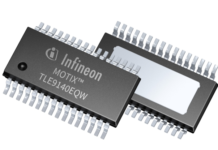
Lynred and Umicore announced the co-development of a next-generation thermal sensing technology which will drastically improve the performance of PAEB (Pedestrian Autonomous Emergency Braking) in adverse lightning conditions at an affordable cost.
Every year, approximately 1.3 million people die as a result of road traffic crashes. More than half are vulnerable road users (pedestrians, motorcyclists, cyclists, etc.) with roughly 75% of these fatalities occurring where visibility is poor. An AAA study revealed that current PAEB systems perform inconsistently and have been shown to be inadequate at night. Increasingly, insurers and rating agencies are advocating for rulemaking to equip passenger vehicles with PAEB systems that work well in the dark.
“Protecting pedestrians in poor visibility conditions makes a strong case for thermal imaging, which is well-established for being efficient in the majority of degraded visibility scenarios (at night, during bad weather, in fog or in sun glare), as it can detect and identify objects at greater distances and with more accuracy,” said Sebastien Tinnes, global market leader at Lynred. “We are delighted to have collaborated with Umicore, a long-time partner, on this exciting project to link together sensors and optics, the two most critical parts of a thermal sensing system, and therefore optimize the capabilities and performance of next-generation PAEB systems.”
Whereas a visible camera, along with a low-beam headlight, can detect at a distance of only 20 to 30m, thermal sensing can detect objects as far as 150m to 300m. Thermal sensing can also classify a living being (cyclist, deer, wild hog etc.) from a distance of 100m to 200m, depending on the sensor resolution (QVGA or VGA, respectively).
Pedestrian Autonomous Emergency Braking
The co-development of the thermal sensing technology for improving next-generation PAEB (Pedestrian Autonomous Emergency Braking) systems, which consists of a new 8.5µm pixel pitch microbolometer designed by Lynred and Umicore’s wafer-level lens technologies, received funding under the European HELIAUS project. In conjunction with other HELIAUS partners, the capabilities of this latest concept in thermal technology for in-cabin and out-of-cabin applications will be demonstrated at AutoSens, a conference dedicated to automotive safety systems, taking place in Brussels, Belgium, September 12 – 15. The thermal sensing solution, notably providing additional information vital for autonomous driving, will be installed in a car equipped, internally and externally, with thermal cameras.
“Thanks to the fruitful collaboration with Lynred’s sensor development team and the other HELIAUS partners, Umicore was able to further refine and incorporate its unique Tessella chalcogenide wafer level optics technology into a groundbreaking, affordable and large volume thermal camera solution which will bring much needed performance improvements to current PAEB systems.” said Mikael Frenkian, business line manager IR solutions at Umicore.
Lynred and Umicore, who have previously collaborated on projects to promote and develop infrared technologies, began working on the HELIAUS project in 2018, along with 11 partners from four countries. During AutoSens, Lynred and Umicore will join fellow partners at booth #30.
Lynred will also make the following presentation during the event:
Title: ‘Thermal imaging to reduce pedestrian fatalities: a case study for AEB’
Date/Time: Tuesday, September 13, 2022, at 12:20pm
Location: Mayhy room



















